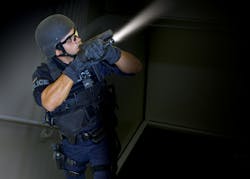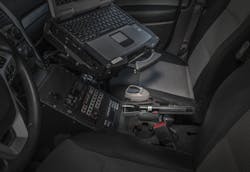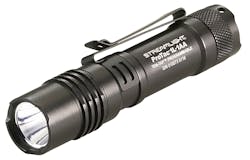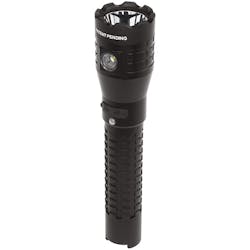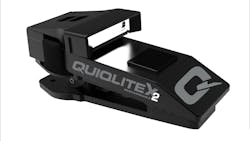Top Features In A Law Enforcement Tactical Flashlight
Brighter is not necessarily better
In order to understand flashlights, it’s pertinent to understand the technology inside the tool. Flashlight manufacturers have been transitioning from incandescent to light emitting diode (LED) products, which produce light approximately 90 percent more efficiently than incandescent light bulbs. According to Energy Star, LEDs are “directional” light sources, meaning that they emit light in a specific direction, as opposed to incandescent bulbs which emit light and heat in all directions and release 90 percent of their energy as heat. LEDs also use heat sinks to absorb the heat produced by the LED and dissipate it into the surrounding environment, keeping the LEDs from overheating and burning out, according to Energy Star. Rather than burning out, LEDs experience ‘lumen depreciation’, where the LED brightness dims over time.
The number one thing many law enforcement look at right now when they purchase a flashlight are lumens, says Scott Field, global vice president of sales and marketing at Mag Instruments. “People will argue that a 1,200 lumen light is better than a 1,000 lumen light and that’s better than a 800 lumen light, but the problem in law enforcement is that brighter does not always mean better.” While there are certainly situations where high lumens are beneficial, there are also downsides. A higher number of lumens produce a lower run time and the increased need for charging. More lumens also produce more heat, making the barrel of the flashlight hotter to hold.
Another downside of having too many lumens is that it can create a blinding situation for officers if it provides an overabundance of light. Brian Quittner, CEO of QuiqLite puts it in perspective. “What happens when you’re reading and writing with a tactical flashlight is you’re shining it on your paper at about 100 lumens or more and it blows out your night vision,” he says. “So when you’re writing that ticket with all that light bouncing back in your face, basically everything around you is blacked out and you can’t see what is going on and your pupil dilation changes because now you’re letting all that light into your pupils. They constrict and they get smaller and when you turn that light off, now your pupils are really small and there is not as much light going into your retina and that makes you not be able to see at night.” While lumens are certainly an important factor when purchasing a flashlight, there are other things that law enforcement also need to consider, including run time, charging options and battery types.
Light to last the whole shift
No doubt, a flashlight is one tool that must work for law enforcement. When purchasing a flashlight, take a closer look at the battery size and chemistry. Some battery chemistries include lithium ion, lithium iron phosphate, nickel-metal hydride and alkaline, to name a few. It’s important to know the differences between each, says Russell Hoppe, marketing manager at Nightstick. “A nickel-metal hydride battery will start to crystallize inside every time you charge and discharge the battery,” he says. “That crystallization is called memory effect and that causes your flashlight to constantly need to be charged.”He notes that because lithium ion batteries don’t have charge memory effect, the number of overall lifetime charging cycles goes up. Hoppe gives this example, “Say I take a charged flashlight with a nickel-metal hydride battery and another charged flashlight with a lithium ion battery and throw them both in the same drawer and let them sit there for 30 days,” he says. “A lithium battery is going to lose 10 percent of its charge. A nickel-metal hydride or nickel cadmium battery may not work at all.”
Agencies must look at battery type and recharging options in the overall cost of ownership. One growing trend allows a flashlight to accept “dual fuel” or multiple source battery back-ups, offering the convenience of using either lithium or alkaline batteries, depending on availability or user preference, says Streamlight’s Taylor. But beyond batteries, law enforcement personnel will also want to look at the charging options, too. One of the biggest trends in flashlight technology is a transition towards USB-rechargeable products, says Taylor. “USB rechargeable lights save time and avoid the worry of not having batteries on hand when they are needed most. First responders can simply connect to a USB port, an AC wall adaptor, or use a USB charger that plugs into a patrol vehicle’s on-board USB port.”
When looking at chargers, law enforcement personnel will be faced with any number of options that affect charging time and ease of charging. Officers should look at what, if any, charging options are including in the cost of the flashlight. Ask yourself: Do I need to take the battery out every time I charge the flashlight? Can I just plug the flashlight into the wall or into the USB to charge it? Will the flashlight last my entire shift and if not, how quickly will it charge? Will I need to purchase a proprietary charger to decrease charge time?
Customization and other considerations
In addition to available lumens, battery size, chemistry and charge time, durability should be a significant consideration for those LEOs looking to purchase a new flashlight. The tradition, says Nightstick’s Hoppe, has always been anodized aluminum, metal flashlights, which are easy to produce but also easy to scratch up. “Today you can purchase products made out of glass filled nylon polymer, a fancy way of saying plastic, but the properties of the glass filled nylon are extremely durable,” he says. Not only is it durable, but polymer is also a lighter-weight, a plus for LEOs who already carry a lot on their duty belt. Hoppe notes that polymer is a molded product too, so the color is through and through. “It also doesn’t absorb the heat and the cold, so it doesn’t absorb the heat from the LED, nor does it crack.”
For LEOs who want options and customization, many flashlights have the ability to be programmed, allowing the user to select different mode sets, lumen output, strobe features, etc.
No one flashlight will work for every officer. The key to finding one that fits your needs is doing in-depth research and understanding the technology in the tool. “Know what you’re buying, know your application and know what it is that you want the flashlight to accomplish,” recommends Hoppe. “What you need is something that is not only going to help you do your job, but a flashlight that will be there for you when you need it.”
About the Author

Adrienne Zimmer
Editor
Adrienne Zimmer was the Editor of Law Enforcement Technology magazine, a monthly business-to-business publication that covers technology trends and best practices for public safety managers from 2017 to 2019. LET is part of Officer Media Group, which also publishes Law Enforcement Product News and Officer.com. Adrienne has been in publishing since 2013.
